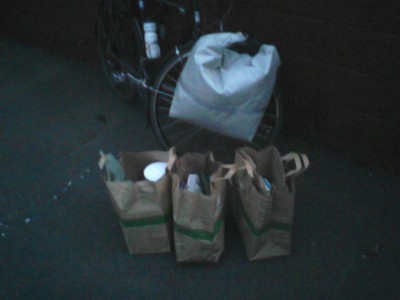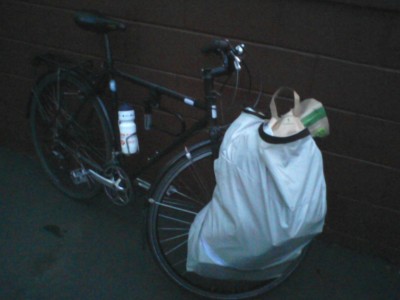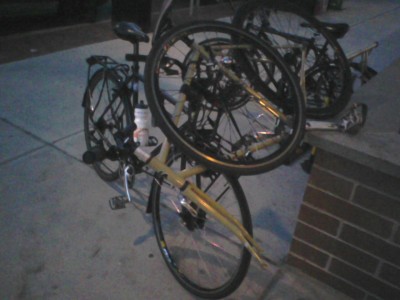Five Items for New Transportation Cyclists; Hot and Dry
March 21st, 2012
I’m not usually a list person, or if I am, I prefer prose. Today, I’ll make an exception and try to summarize the top things someone new to transportation biking should be aware of.
- Learn how to ride safely on the road. My mantra is be visible.
- Get a bike that fits, and keep it in working condition. There are lots of factors for a good bike fit, but for commuting and getting around, generally you want a bike that keeps you sitting more upright so you can see and be seen (how fashion-conscious!) on the road. If you hear squeaks of agony (from the bike) or the brakes aren’t snappy, get that taken care of by a shop.
- Figure out routes that work for you. You’re going to be taking different roads than if you were walking or driving. While Google Maps has biking directions, I find them to be generally pretty bad because of their slavish devotion to marked bike routes (a nearly meaningless distinction, usually). Find what works for you be trial and error and talk to other bikers.
- Decide how you’re going to carry things. Don’t put things on your back if you want to arrive presentable. Don’t put things on your handlebars if you want to survive. Instead, get a rack with panniers or a basket.
- Figure out dress that works for you. I know this is particularly an issue for ladies, but you’ll have to prepare by wearing much cooler outfits (when you’re rocking and rolling along) and much warmer outfits (when it’s windy or cold and you’re not generating as much heat).
That about sums it up. Now I can stop blogging, forever. 🙂
In other news, I posted my instructions for the Large Panniers for CETMA rack. Whether you make these bags or a different roll-top type pannier, I hope these instructions are helpful.
Weather (from 3/20)
Temperature: 81
Road condition: Dry
Clothing: Long sleeve T-shirt, jeans, loafers (w/o socks)
Comfort: Awful. As you might imagine, the best way to deal with this temperature is light fabrics and short sleeves. I was in a black T-shirt and jeans. Don’t do that.
If I were commuting to an office at a morning temperature above 70, I would neatly store my button-up shirt, and untuck the undershirt, and take it slowly. Or, if you’re going far enough, plan on changing clothes.
More Big Panniers; Cold and Dry
March 5th, 2012
I won’t harp on it any more, but on Friday night I made a matching really big pannier of the same design (Woo! Party!) as my original. It was fast and easy; I also took the back rack off my commuter. I’ll report back after loading up the front with a ton of weight. I also have a page in the works for the design on the pannier. I’ll try not to bore you too much more on this subject, dear reader.
After last week’s snow riding, I let my bikes sit in an enclosed area for three days so they could breed surface rust. I cleaned the commuter yesterday; I’ll need to bring the mountain bike in to get a wipe-down, probably tonight.
Weather
Temperature: 29
Road condition: Dry
Clothing: Heavy winter coat, timberland shoes, light Pearl Izumi gloves. I forgot my Nutcase helmet at home, so I had the traditional Bell Venture today: my whole head, but especially my ears, were notably colder.
Comfort: Aside from the ears, perfect! I rode pretty hard without working up a sweat at all.
Ridiculously Large Panniers; Cool and Dry
February 28th, 2012
On Saturday, I finished up my home-made pannier project. It’s a simple roll-top design, made of 430D Nylon pack cloth (a fabric on the lighter side, it turns out), and is absolutely gigantic. For example, I carried three bags of groceries in it. It compromised my steering less than you would think…
I made the pannier for my Cetma rack, as there didn’t seem to be good commercial options for it. It attaches by four velcro straps around the fork and rack strut, as well as straps that reach down from the rails on the rack. The idea is that I could still strap items to the rack deck itself while having loaded panniers.

The pannier, unloaded and clipped shut: I put four or five rolls in the top to close it to its rough "design" size.
When I first completed it, I thought it was too big. However, I like being able to move the kitchen sink. I’m going to make a matcher, and then probably remove my rear rack and start looking for a two legged kick stand that fits on the Crosscheck. After the second go-around, I’ll try to put out some how-to for any other home-made gear enthusiasts.
Weather
Temperature: 41
Road condition: Dry
Clothing: Heavy winter coat, timberland shoes. I took off my gloves (light EVO ones) pretty quickly.
Comfort: I was riding pretty fast the whole way, so I ended up getting a bit too warm. Otherwise, lovely!
Boston Bike Bloggers; Cool and Windy
February 24th, 2012
Yesterday was the inaugural meeting of Boston-area bike bloggers (or in internet parlance, BABBA). Some of those in attendance were (the people behind) Bike Safe Boston, Commonwheels Coop, Hub Bicycle, Bikeyface, Boston Cyclists Union, Steve Miller and, obviously, theHumble Cyclist, as well as a variety of non-blogging bike enthusiasts. A good time was had by all, and those who stuck until the end of the night had a little convoy north of the river, where many of the “Boston” bike bloggers seem to reside. Following on our discussion of promoting road safety with blogs, no traffic laws were broken on the ride home; I also observed an unusually high number of people able to do track stands. I don’t know when the next meeting will be, but I encourage all to attend as either blog readers or writers!
Following yesterday’s promise to “portage” one bike with another, I managed to follow through without too much fuss!
I did put some scratches on the “top” bike from its rubbing against the wheel axle (lesson: don’t put the removed wheel against the frame), as well as somehow getting grease on my pants (lesson: if you handle the dirty bits on a bike, you will get dirty). I consider these minor costs to advancing the world’s bike mobility!
Weather
Temperature: 37
Road condition: Dry
Clothing: Heavy winter coat, timberland shoes, EVO gloves
Comfort: Worked well; the wind-breaking covers on the EVO gloves warmed up my hands after I started the ride without them.
Everybody got scared off by the weather forecast today (it is currently snowing!), although the snow didn’t start falling until after 9 am, and should be done by the evening.
Carrying Things (II); Cool and Dry (again)
February 10th, 2012
Today I’m going to follow up on my previous “Carrying Things” post by talking about big, bulky items. You know, the kind that don’t fit in yours, or anyone else’s bag, such as two weeks of laundry, a CSA share, another bike, or large packages of paper towels. These are the kinds of things I move with alarming frequency with the bike. The only practical way I’ve found to do it is with a front rack (I use a Cetma rack). Other methods, such as a back rack (a device created solely to eject cargo from your bike), or balancing on your handlebars (hard to steer when your arms are busy with other things) aren’t up to snuff. Good alternative I haven’t tried are a bucket bike (bakfiet), basket, or a trailer. Is anyone else moving moderately sized things with their bike?
Weather Today
It was a little warm today, beautifully sunny, but actually shockingly comfortable.
Temperature: 35 degrees
Road condition: Dry
Clothing: Heavy winter coat, Timberland shoes, messenger bag
Comfort: Tiny bit warm, easily solved by removing my gloves
Spring Is Here (?); Bags
January 24th, 2012
I should announce in advance any time I have to wear a suit to work: it is highly correlated with weird weather. Often it’s a heavy storm or cold snap, but today it appears to be freakishly warm (46 degrees this morning).
Technically, wearing a suit is no different from wearing other clothing. However, for me it adds a few complications: the jacket (what to do with it, as it’s long and sticks out of coats), cleanliness (you don’t want to get grit or slush on that bad boy), and the shoes (I usually leave my shoes at my desk). If this were most any other season, I might consider just wearing everything. Since this is the Dirty Season (winter to the lay person), I wear my rain pants, any coat, my normal bike-to-work shoes, and pack the jacket and shoes in panniers.
Clothing: Rain jacket, rain pants, waterproof shoes. No gloves.
I got a little warm riding in despite the light clothing. The key is airflow. I already had the tie knotted, and the shirt tucked in; the rain clothes add extra constriction. However, the biggest factor that kept me from getting actually sweaty was the bag. Any kind of bag on your body (whether two strap backpack or a messenger bag) will effectively increase the temperature by at least 10 degrees. The reason is airflow, for two reasons. The first is that there’s no air whatsoever under the straps: your body tries to remove heat, and so it sweats and nothing can escape. This ends up soaking your clothing in weird patches. Second, the straps obstruct any air from circulating between your skin and the openings in your clothing (around your neck, arms, and maybe lower back), which raises your overall temperature. If I want to arrive someplace presentable, I go for panniers.
Since I’m recommending them, I’ll go ahead and say that most any pannier will work. I have Axiom Typhoon LX panniers because that’s what the store had when I urgently needed a bigger bag the night before leaving on a touring trip. (It turns out the saying is true that you will fill whatever size bag you have, however.) They’re dry bag style, totally waterproof, and a giant sack. That’s not ideal because whatever you need is inevitably on the bottom of the sack, however the waterproof property and tough material makes these a good buy.


